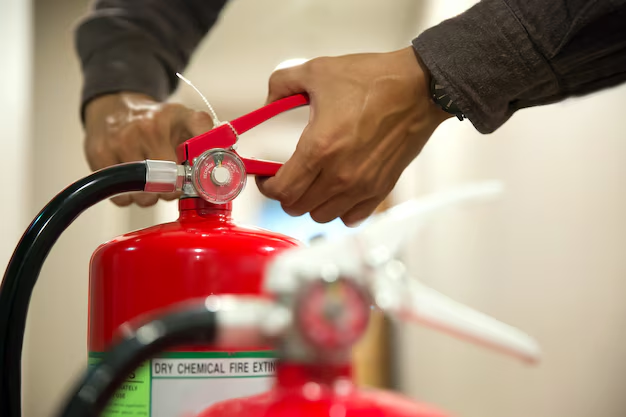Imagine a small fire igniting on your kitchen counter, panic starts to rise. Luckily, you have a fire extinguisher nearby. With a quick grab and practiced pull, you can extinguish the flames to prevent kitchen fire. Now the question arises which type of extinguisher do you need to prevent electricity fire? How to use it safely? Let’s jump into the world of fire extinguisher foam and its use guide.
What Is A Foam Fire Extinguisher?
Foam is one of the most frequent types of fire extinguishers that might be used against fires having combustible liquids and solids like wood, paper, and petrol.
Additionally, foam can easily tackle thick flammable liquids like cooking oil, gasoline, and even paint. This versatility makes it perfect for commercial buildings, hospitals, and schools.
You can make a huge difference by having and using a foam fire extinguisher. It can turn a small fire into a minor inconvenience, preventing extensive destruction.
Foam Fire Extinguisher Sign
A foam fire extinguisher identification sign is a fire extinguisher. The prime purpose of this sign is to help people to know where the foam fire extinguisher is located.
Moreover, it carries the message “Foam”, showcasing that the fire extinguisher is a foam type.

Is Fire Extinguisher Foam Toxic?
Generally, yes. it could be dangerous due to contain different chemicals. As mentioned above, fire extinguisher foam tackles Class A and Class B fires involving common flammable liquids. This makes them ideal for laboratories, factories, warehouses, and hospitals at risk of these types of fires.
Water-based fire extinguishers restrain some additional chemicals. Ingestion of these chemicals might be harmful. Therefore, when using a fire extinguisher foam, I recommend wearing goggles, and waterproof gloves for protection.
What Is Fire Extinguisher Foam Made Of?
- Made-Up: It is made up of water, foam concentrate, and air, forming a homogeneous foam blanket.
- Small Air Bubbles: This small blanket is filled with many small air-filled bubbles.
- Density: The foam is lower than oil, water, or gasoline.
Foam Fire Extinguisher Use
First and foremost, it’s crucial to remember that you should only attempt to put out a fire if you can tackle it safely. Leave it to the fire and rescue services and focus on a safe exit if the fire has gotten out of control or if you don’t know how to put it out. Here are a few instructions for applying a foam extinguisher:
Step# 1:
Find the cream-labeled extinguisher. Remove it from the wall bracket or floor unit.
Step# 2:
Next, remove the safety pin from the handle, breaking the tamper seal, and hold the extinguisher firmly by its bottom carrying handle. Be careful not to accidentally depress the lever handle on top.
Step# 3:
With one hand still gripping the handle, squeeze the lever on top with your other hand.
Step# 4:
Now it’s time to target the flames! Use the nozzle to direct the foam stream right at the base of the fire according to the type of fire and material you are using.
Solid combustibles: From a safe distance, use the nozzle to aim the foam being released toward the fire’s base and sweep over it.
Flammable liquids: To generate a blanket of foam that stifles the fire by preventing oxygen from reaching it, direct the foam towards a vertical surface near the fire. Foam should not be poured directly into the liquid as this might splatter and exacerbate the fire.
Step# 5:
Make sure the extinguisher is fully discharged, covering the area to extinguish the fire completely. This will also allow it to cool down. The foam will help form a cooling layer, lowering the chance of the fire re-igniting.

A Foam Fire Extinguisher Should be Used on an Electrical Fire?
No, foam fire extinguishers should not be used on electrical fires because foam conducts electricity, posing a shock hazard. For electrical fires, use a CO2 or dry powder extinguisher. Always turn off the power source before attempting to extinguish the fire.
What to Do If You Can’t Extinguish the Fire?
If you’re unable to extinguish the flames yourself, Don’t wait for a disaster! Even small fires can spread quickly. Prioritize safety and evacuate the building immediately. Remember, your life is more important than property.
Once you’re safe, call N8 Fire and Safety Services for a quick response. Our expert helps you handle these kinds of emergencies and ensures your property is protected.
N8 Fire and Safety – your reliable partner in fire safety solutions.






